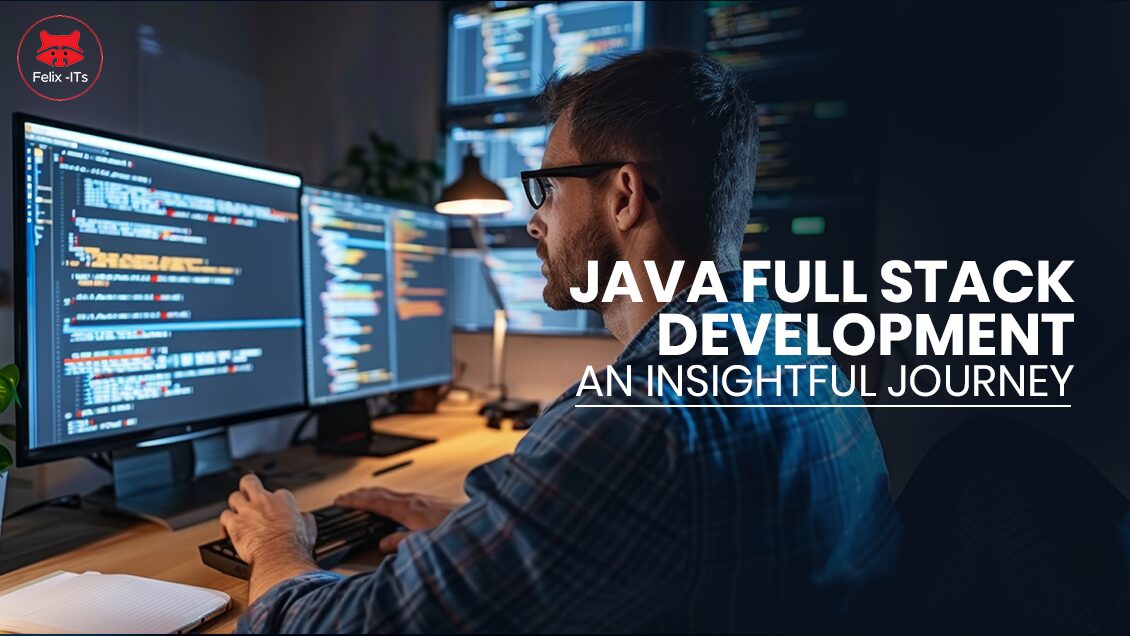Java Full Stack Development is a dynamic and rewarding field that combines the power of Java with modern front-end and back-end technologies. This comprehensive approach equips developers with the skills needed to build robust, scalable, and efficient applications. Whether you’re experienced or new, mastering Java Full Stack opens doors to diverse opportunities. Felix-IT Systems is a leading institute in India offering the best Full Stack Development with Java Courses.
In this article, we will explore this domain through a practical example to showcase its vast potential.
What is Java Full Stack Development?
Firstly, let’s take a brief look at what Java Full Stack Development is. Java Full Stack Development involves working on both the front-end and back-end of an application. A full-stack developer is proficient in creating user interfaces, handling server-side logic, and managing databases. The primary technologies involved in Java Full Stack Development include:
- Front-end: HTML, CSS, JavaScript, Angular, React
- Back-end: Java, Spring Boot, RESTful APIs
- Database: MySQL, MongoDB
- Version Control: Git
- Deployment: Docker, Kubernetes
Why Choose Java for Full Stack Development?
Java’s platform independence, scalability, and strong community support make it ideal for full-stack development. It ensures applications can run on various platforms seamlessly, and scales well with growing demand. This offers abundant resources for learning and problem-solving. Such advantages establish Java as a top choice in the field. Let’s take a look at some of the reasons in detail!
Robustness: Java’s strong type system and exception handling make it a robust choice for back-end development.
Scalability: Java applications can efficiently scale to handle increased loads, making it ideal for large enterprises.
Community Support: An extensive community and a wealth of libraries and frameworks ensure continuous support and innovation.
An Example: Building a Blog Application
To illustrate the power of Java Full Stack Development, let’s consider building a simple blog application. This application will allow users to create, edit, delete, and view blog posts. Here’s a step-by-step overview of how we can achieve this:
Step 1: Setting Up the Front-end
Using Angular, we’ll create a responsive user interface for our blog application. Angular’s component-based architecture allows us to build modular and reusable UI components.
Home Component: Displays a list of blog posts.
Post Component: Allows users to view individual posts.
Editor Component: Enables users to create and edit posts.
Step 2: Develop the Back end
For the back end, we’ll use Spring Boot, a powerful framework for building Java applications. Spring Boot simplifies the process of setting up and configuring the back-end server.
PostController: Handles HTTP requests for creating, reading, updating, and deleting posts.
PostService: Contains the business logic for managing posts.
PostRepository: Interacts with the database to perform CRUD operations.
Step 3: Integrating the Database
We’ll use MySQL as our database to store blog posts. Spring Boot’s JPA (Java Persistence API) makes it easy to interact with the database.
Post Entity: Represents a blog post in the database.
Application.properties: Configures the database connection.
Step 4: Connecting Front-end and Back-end
Using RESTful APIs, we’ll connect the Angular front-end with the Spring Boot back-end. Angular’s HttpClient module will help us make HTTP requests to our back-end APIs.
API Endpoints: Define routes for CRUD operations, such as `/api/posts` for creating a new post and `/api/posts/{id}` for fetching a post by its ID.
Step 5: Deployment
Finally, we’ll deploy our application using Docker. It allows us to package our application into containers, ensuring it runs smoothly in any environment.
Dockerfile: Contains instructions for building the Docker image.
docker-compose.yml: Defines services, networks, and volumes for our application.
Conclusion
Java Full Stack Development is a powerful and versatile approach to building modern web applications. By leveraging the strengths of Java, Spring Boot, Angular, and MySQL, developers can create robust, scalable, and efficient applications. The example of a blog application demonstrates how these technologies work together seamlessly to deliver a full-fledged application.
Whether you’re looking to enhance your skill set or embark on a new career path, mastering Java Full Stack Development can open doors to exciting opportunities. At Felix IT Systems, we offer comprehensive training programs in Java Full Stack Development, tailored to meet the needs of aspiring developers in Pune, Mumbai, Thane, and Ahmedabad.
The best thing about our courses at Felix-IT Systems is the detailed course, expert faculties and the industry-aligned learning approach. Since the course is suitable for anyone and everyone. students and professionals alike are welcome for it. Another unique advantage of studying at Felix-IT Systems is the placement support upon completion of the course. This placement support has allowed a ton of students to not only pursue the course but also find the desired career openings with relative ease.
Enroll today and take the first step towards becoming a proficient full-stack developer with Felix-IT Systems!



